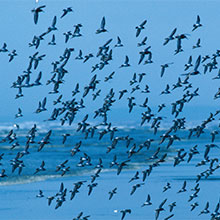Passing Passerines -Fall 2016
by: Virginia Andrews
Fall is a time of transition for birds as well as people, and these are golden months on Nantucket, when we never know what will show up.
In the fall there are many young birds, the so-called “birds of the year.” Some birders like to refer to them as “the Class of 2016.” Populations are at peak numbers, both for year-round residents and migratory species. Hatched here or in northern forests or tundra, migratory birds must all attempt to find their way south to get food in the winter. Many follow the coasts, where the ocean, slower to warm in spring, but also slower to cool than the land in the fall, moderates the temperatures. This allows insect life – bird food to them – to continue later in the season. For them, Nantucket is an oasis of life in an otherwise inhospitable ocean.

Migratory birds leave the nest, and their home patch, to fly thousands of miles to a place they have never seen before. And if they are smart, strong and lucky, the next year they return to the area where they hatched. Scientists still do not know exactly how they navigate. Banding and geolocator studies clearly indicate that they find their way back and forth with incredible accuracy. Birds have done so for millions of years, all without the benefit of maps, compasses or chronometers. They somehow evolved a biological GPS. It is difficult to tease out facts from highly-mobile wild creatures, but scientists are getting intriguing results.
Subscribe to Nantucket Today to read the full article.